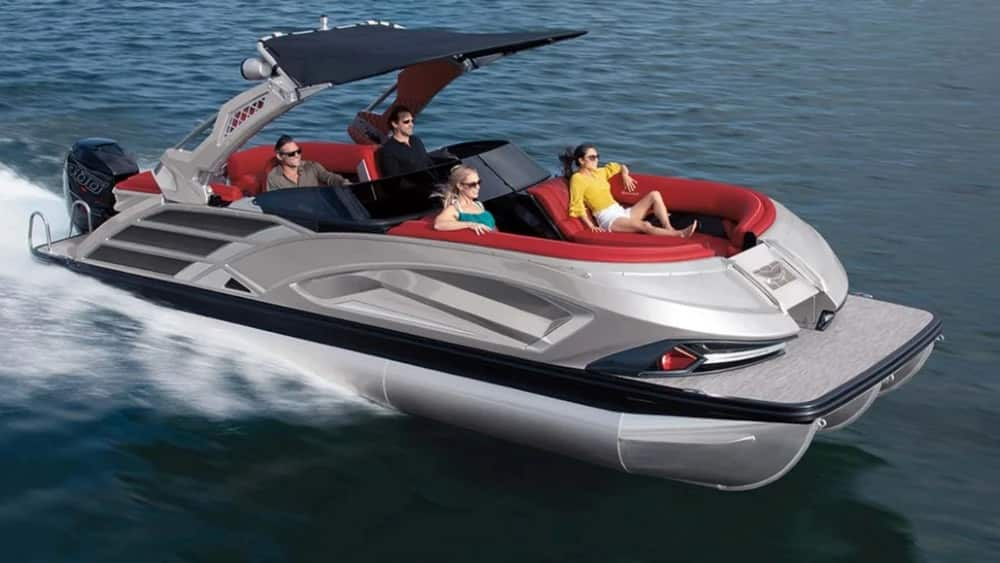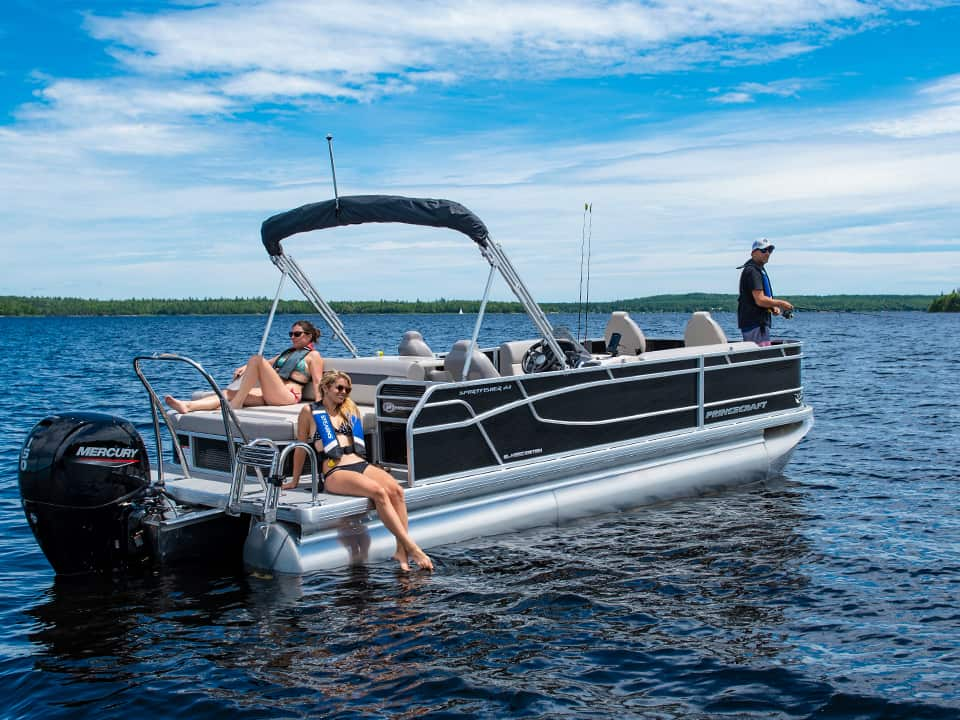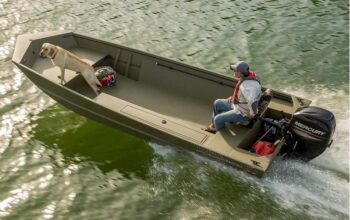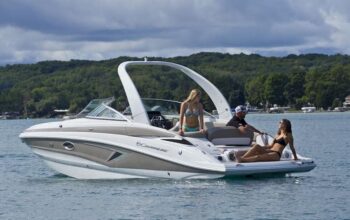If you must know, what is a pontoon boat?
Pontoon boats: In order to float, pontoon boats are a particular kind of recreational vessel. Recent advancements in the design and use of pontoons have helped boat dealers reclaim their former prominence. They have historically been fairly slow, which makes them ideal for outdoor activities like partying and even fishing and sunbathing.
More quickly than in the past are pontoon boats for sale today. Numerous manufacturers are able to provide a luxurious pontoon boating experience with upscale interiors due to the design’s simplicity. However, even the most basic contemporary pontoon boats can turn as sharply as vessels with fiberglass hulls. These boats are typically between 14 and 30 feet long.
Please continue reading for more information.
Table of Contents
What Is The Purpose Of A Pontoon Boat?
A pontoon boat is a very adaptable type of boat, despite the fact that it might not look like your typical watercraft. Under the right circumstances, they are simple to operate, maintain, and very safe. For a first-time boat owner, pontoon boats may be the ideal option. They can be very opulent and are highly customizable. Pontoon boats serve commercial purposes in addition to being used for recreation. Some uses of pontoon boats are:
Recreational
- Fishing
- Entertaining
- Moderate-level water sports
- Snorkeling
Commercial
- Tours
- Ferry
- Utility
- Mini-barge
What Distinguishes A Deck Boat From A Pontoon Boat?
In that they can accommodate lots of people, deck boats and pontoon boats have a similar use. The typical pontoon has a flat, open deck that provides more room for walking and can accommodate more people than a deck boat of a similar size. A deck boat, on the other hand, usually has more storage space but less walking space.
The type of hull each boat has makes the biggest difference. A deck boat has a single V-shaped hull, whereas pontoons have a catamaran-style hull with two parallel floats. Both are simple to use, but deck boats will handle better. Additionally, deck boats are slightly more expensive.
The distinction between a pontoon boat and a deck boat is becoming more hazy as manufacturers improve design and functionality. Both of these types of boats are excellent. If you have to pick between the two, style might be all that matters. To learn more about renting a boat in Florida, read our helpful guide if you want to give one a try.
Do Pontoon Boats Travel Quickly?
Pontoon boats have a well-deserved reputation for being cumbersome, slow, and difficult to control. But thanks to manufacturers, who created contemporary pontoons with performance and handling in mind, all of that is history. In the past, 25 mph was thought to be a fast speed in a pontoon. Today, however, even a typical off-the-lot pontoon can travel at almost twice that speed. Even surpassing 100 mph is possible with some high-performance pontoons! Pontoon boats can undoubtedly travel at the speeds required for leisure activities, despite still not being a common choice for skilled watersports competitors.
Can Pontoon Boats Be Trusted In Choppy Waters?
Pontoon boats are remarkably stable when used in calm water. In fact, more so than a conventional single-V-hull boat. On the contrary, this is true in choppy water. However, pontoon boats can operate safely in even moderately rough water if the right safety measures are taken. It’s important to remember that larger pontoons are more stable than smaller ones. If the water in your preferred boating location is typically choppy, think about getting a bigger boat to compensate. Knowing the limits of your boat and making plans accordingly is the most crucial safety measure. Always check the forecast, and if necessary, don’t be afraid to postpone your day on the water. Your upcoming fantastic boating day is only a few days away! Seee more about What Is A Jon Boat?
What Is The Ideal Size Of A Pontoon Boat?
Pontoon boats come in a wide range of sizes, from one-seater personal watercraft to vessels longer than 30 feet. To choose the appropriate boat size for you, take into account the capacity and your activities.
A 15-footer will do for entertaining a small group of people. Look between 16 and 20 feet away for six to ten people. You’ll need a pontoon longer than 20 feet for groups of more than ten. You will need a sizable pontoon that is at least 22 feet long if you enjoy water sports. Larger pontoons are more stable at high speeds and can accommodate the larger motors required.
Review your state and local laws for any size restrictions before you buy, which is extremely important. Even specific water bodies can have restrictions. You don’t want to acquire a boat that you can’t use.
Which Motor Size Is Required For A Pontoon Boat?
You’ve discovered the ideal pontoon boat. Only one piece of the puzzle remains, though. Finding the appropriate-sized motor will determine how much you can enjoy it. But when choosing the best motor for you, there are a few factors that come into play:
Size/weight
As you might expect, a larger motor will be required to achieve the same speed on a larger boat. It’s crucial to take into account the maximum weight that your vessel is likely to carry. Even a few extra guests and a full tank of gas will add significantly to the weight and, consequently, performance.
Intended Use
You can get by with a little or no motor if your typical day on the water involves lazily cruising on a calm lake with a few friends. You should think about a powerful motor if you engage in watersports or provide entertainment for large crowds.
Budget
While it is better to err on the side of a slightly larger motor than is necessary, try to avoid paying too much for a motor that is significantly more powerful than you actually need. Motors with more horsepower can be just as expensive as the boat itself.
A boat’s motor selection is just as critical. It is therefore advisable to consult a knowledgeable dealer who can assist you in determining your needs and locating the ideal motor for you and your way of life.

What Kind Of Motors Are On Pontoon Boats—inboard Or Outboard?
The majority of pontoon boat motors are by far outboards. Although inboard motors are an option for pontoons, their popularity isn’t very high. You probably wouldn’t notice any benefits of having an inboard motor unless you engage in tow sports like skiing, where the extra power and an open transom are essential. Additionally, an inboard engine block may significantly encroach on your deck space depending on where it is located. So, on your pontoon, stick with the tried-and-true outboard motor unless you have a specific need for an inboard motor.
What Differentiates A Pontoon From A Tritoon?
The two identically sized, air-filled tubes that run lengthwise along each side of the boat—known as the pontoons—are what distinguish a pontoon boat from other types of boats. A trioon is merely a pontoon with a third tube. Typically, the central tube of a tritoon is lower or has a slightly larger diameter than the outboard tubes. There are many factors to weigh when considering the purchase of a tritoon over a pontoon:
Tritoon Advantages:
- Tritoons are safer because they maintain their stability at higher speeds and in choppy or turbulent water.
- Smoothness – With the stability of a pontoon, you experience a smooth ride comparable to that of a v-hulled boat.
- Performance: Tritoons are more suitable for high-performance watersports because they are bigger and more stable, which allows them to handle larger motors.
Tritoon Disadvantages:
- Tritoons cost up to 75% more than pontoons, which is a significant difference in price.
- Dimensions: The typical tritoon is much bigger. When storing, trailering, or docking your boat, keep the extra size in mind.
- Ability – It will take more ability to operate if you want to take advantage of the bigger engines and higher performance.
- Calm water – If you only intend to slow cruise on calm waters, you are essentially paying a premium price without experiencing any of the advantages of a tritoon.
Uses For Modern Pontoon Boats
AD
Numerous tasks that go beyond those initial design objectives can be accomplished by modern pontoon boats.
- Fishing: Pontoon boats are excellent for fishing because they were made for it. They can go into the shallowest waters in search of fish because of their stability on the water and shallow draft, which means they can go where almost no other boats can. They also expanded the deck area to accommodate more anglers and their equipment. To make a fishing trip simpler, modern fishing pontoons may also come with live wells and other accessories.
- Leisure cruising: The versatility of pontoon boats for both family and solitary use is unmatched in this situation. You probably won’t ever experience a ride as calm and smooth as one in a pontoon boat on inland waters when the weather is calm. Many pontoon boats have lower horsepower motors, so they aren’t built for or capable of reaching any genuinely heart-pounding speeds.
- Water sports and snorkeling: Aside from what I just said, some pontoons, particularly tritoons, can have engines that are much more powerful. You can achieve speeds perfect for tubing and water skiing with the help of two 350-hp engines on a tritoon boat. Slides, ladders, and other amenities can be added to larger pontoons in the 25 foot and above range, making snorkeling and other water sports much more affordable and appealing options.
- Party boats: There is actually a model of pontoon boat sold under the name “Party Barge” which should give you an indication of how these boats can comfortably accommodate gatherings on the water. Without exceeding the weight restrictions of the boat, a 27 foot party boat could comfortably fit up to 15 people. Because of this, pontoon boats are frequently rented out as part boats, and some people operate businesses on lakes where people can congregate on larger pontoons for parties with bars and music. However, a pontoon boat can only hold so many people, compared to other boats of a similar size. There is a weight limit for each pontoon boat that must be followed. The issue is that the boat will have enough room to hold more passengers than its carrying capacity will permit. Due to being so heavily loaded, pontoon boats have sunk as a result, and this is something that can happen. It is not a good idea to overload a pontoon boat that is designed to hold 15 people, even if 20 people can fit on the deck.
- Tours: Again, because of their stability and all-around smooth ride, pontoon boats are frequently used as tour boats on rivers and lakes to point out the local scenery to tourists and visitors. Pontoon boats, in the opinion of many boaters, provide the most gentle ride you can possibly get on the water as long as the water is calm. Even seasick people generally agree that a pontoon boat is much easier on their stomachs, and even if they do experience motion sickness, it’s typically much less severe than it would be on a traditional boat.
- Ferries: Due to their capacity to carry heavy loads while still maintaining a generally smooth and stable ride, a number of larger ferries may be tritoon boats. Despite frequently being much larger than conventional recreational pontoons, these commercial pontoons operate on essentially the same principals.
Characteristics Of Modern Pontoon Boats
There are a few characteristics of pontoon boats that, regardless of their intended use, really get to the heart of who they are and what they do.
- Pontoons: A boat cannot be a pontoon boat without the pontoons that define it, which is somewhat of a no-brainer. This is the single most crucial element in defining a pontoon boat correctly. Anything that is sealed and capable of providing buoyancy can be used as a pontoon. If it doesn’t have tubes under the deck, it can’t be a pontoon boat. That was the case with the original design, in which the pontoons were merely sealed barrels. Later pontoons were made of long aluminum tubes, but these proved to be ineffective if they were damaged. The tube would fill with water if it developed cracks or breaks, causing that side of the boat to sink. A damaged pontoon would capsize the boat on one side because the pontoons balance the boat, and there was also a chance that the boat might flip. Today’s pontoons use chambered tubes. The pontoon tube will have several sealed compartments inside even though it appears to be one continuous tube from the outside. In this manner, only one chamber will flood if the tub sustains structural damage severe enough to lead to a break. Even though the pontoon will lose some buoyancy, it should still have enough in combination with the other tube or tubes to transport the boat back to land for repairs safely.
- Flat Deck: The other key aspect of a pontoon boat from the same early design that Mr. The flat deck was created here. In its original form, a pontoon boat was nothing more than a flat deck. Modern pontoons will likely have seats, railings, and other amenities, but the deck space will always be one of the main selling points of a pontoon. They can be used as family or party boats in addition to fishing boats because of this. More people and equipment can be carried on board thanks to the larger deck area than on a boat of a different type of similar length.
- Stability: Unmatched stability is offered by a pontoon boat’s dual and, to a greater extent, triple pontoons. In calm waters, it is nearly impossible for a pontoon boat to flip or capsize unless the pontoons themselves become damaged. In a conventional fishing boat, even one with a flat bottom and a shallow draft, rocking back and forth would immediately make the boat feel unstable. The boat might tip over and fill with water if only a few passengers lean to one side at once. This might even cause the boat to capsize. Considering that the boat’s actual structure is submerged in water. The same is true of kayaks, canoes, sailboats, jon boats, bass boats, and even kayaks and canoes. In a pontoon boat, you are more on the water than you are in it. The shallow draft of the pontoons is true, but it is hardly noticeable if the boat is not overloaded and the rest of the craft makes no contact with the water. As a result, tipping a pontoon boat requires much more weight and effort, and is more likely to occur in one of two situations: either the boat is severely overloaded, or the weather has changed and the water is rough.
- Control: Even though operating a pontoon boat differs from operating a regular boat, it is very simple to do. Turns are frequently wider and require more time to complete.
- Motors: It’s a myth that all pontoons have outboard motors. Although sterndrive or inboard motors are sometimes used in more recent pontoon boat models, outboard motors still account for the vast majority of them. An inboard motor is used in a number of Bennington models instead of an outboard engine, which company is well known for producing some of the most expensive, luxurious pontoon boats. These enable watersports more easily than an outboard and might be more appropriate for the bigger and heavier pontoons that are currently on the market.
Conclusion
A pontoon boat is, to put it simply, a boat with a flat deck that rests on two or three pontoons, which are buoyant tubes filled with air. However, manufacturers are making pontoons much more complex than just this straightforward description as they experience a renaissance with boaters today. Modern pontoons are perfect for cruising, fishing, water sports, and nearly any other activity you can think of on inland lakes and calmer waters. The cost of a typical pontoon boat is frequently lower than that of other boats of a similar design, but it can increase significantly with more luxurious models.
I appreciate you reading.




